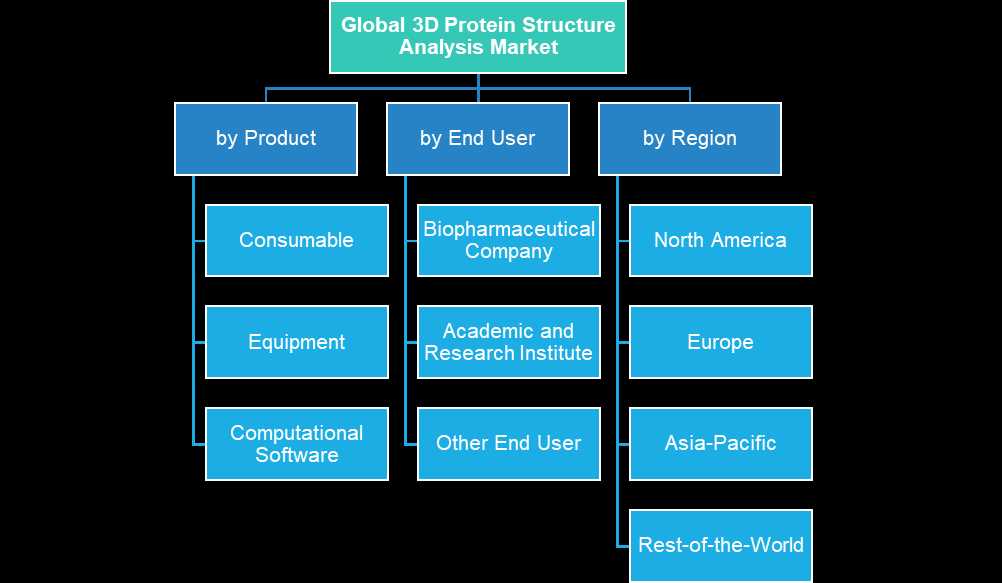One of the primary objectives of molecular biology research is to identify the structure of proteins. Protein complex analysis requires a thorough research of proteins' structure and function because they are found in complicated biological samples. The structure of protein complexes can be ascertained using contemporary protein complex analysis methods. Many studies are currently being conducted employing cryo-electron microscopy (EM), small angle X-ray scattering (SAXS), nuclear magnetic resonance (NMR) spectroscopy, and X-ray crystallography to describe and understand molecular structures and molecular recognition mechanisms. Equipment for 3D protein structure analysis is available from reputable manufacturers including Bruker Corporation, JEOL Ltd., and Spectris plc depending on what is required. These tools can meet the laboratory's throughput requirements.
In 2021, the global 3D protein structure analysis market was valued at $1,017.2 million, and it is expected to reach $2,676.6 million by 2032, growing at a CAGR of 9.32% during the forecast period 2022-2032. The growth in the global 3D protein structure analysis market is expected to be driven by technological advancements in equipment for protein structure analysis and by an increase in RD expenditure to accelerate protein structure analysis.

Impact
• The presence of major equipment providers of 3D protein structure analysis has a major impact on the market. For instance, in April 2022, NJ Biopharmaceuticals LLC and JEOL Ltd. announced their collaboration to bring innovative drug discovery platform solutions using JEOL's 800 MHz NMR. With the help of this partnership, JEOL Ltd. aspires to grow its 3D protein structure analysis base and increase its existing product line.
• In August 2020, Thermo Fisher Scientific Inc., a global leader in providing scientific services, announced that it would facilitate access to cryo-electron microscopy (cryo-EM) by connecting pharmaceutical and biotechnology companies with contract research organizations (CROs) that provide start-up packages for this game-changing technology as a service.
Recent Developments in Global 3D Protein Structure Analysis Market
• In February 2022, JEOL Ltd. announced the development of a new cold field emission cryo-electron microscope (cryo-EM), the CRYO ARM 200 II (JEM-Z200CA), dedicated to single particle analysis of proteins.
• In November 2021, JEOL Ltd. announced the availability of "ECZ Luminous" nuclear magnetic resonance console (JNM-ECZL series). This product is the next step in spectrometer miniaturization and extended performance through state-of-the-art digital and high-frequency technologies.
• In October 2020, Thermo Fisher Scientific Inc. introduced two ground-breaking imaging filters, i.e., the Thermo Scientific Selectris Imaging Filter and the Thermo Scientific Selectris X Imaging Filter, which elevated cryo-electron microscopy (cryo-EM) to a new level by allowing users to view proteins at true atomic resolution.
• In April 2021, Thermo Fisher Scientific Inc. unveiled the Thermo Scientific E-CFEG, a significant accessory for the Thermo Scientific Krios Cryo-TEM and the company's new cold field emission gun. In comparison to other commercially available technologies, the E-four CFEG's key components work together to achieve single particle analysis (SPA) resolution levels that are unprecedented.
Global 3D Protein Structure Analysis Market Segments

Demand – Drivers and Limitations
Following are the demand drivers for the global 3D protein structure analysis market:
• Technological Advancements in Equipment for Protein Structure Analysis
• Increase in RD Expenditure in Drug Discovery and Development
• Rising Focus on Automation and Miniaturization in X-Ray Crystallography Workflow
The market is expected to face some limitations too due to the following challenges:
• Certain Instrument Limitations Pertaining to 3D Protein Structure Analysis
• Lack of Qualified Personnel
• High Cost and Time-Consuming Method
Key Market Players and Competition Synopsis
The companies that are profiled have been selected based on inputs gathered from primary experts, analyzing company coverage, product portfolio, and market penetration.
Some of the prominent names established in this market are:
• Bruker Corporation
• JEOL Ltd.
• Spectris plc
• Thermo Fisher Scientific Inc.
• Merck KGaA
• Schrodinger, Inc.
• Molecular Dimensions
• Arinax Scientific Instrumentation.
• Cambridge Isotope Laboratories, Inc.
• HAMPTON RESEARCH CORP.
• DNASTAR
• RosettaCommons.org
• Rigaku Corporation
• Dassault Systemes
• Jena Bioscience GmbH
Get Free Sample Report - https://bisresearch.com/requestsample?id=1364type=download
Key Questions Answered in the Report
- What are the major market drivers, challenges, and opportunities and their respective impacts in the global 3D protein structure analysis market?
- What is the potential impact of technological advancements among the key end users, such as biopharmaceutical companies and academic and research institutes?
- What is the current market demand along with future expected demand for the global 3D protein structure analysis market?
- What are the key development strategies that have been implemented by the major players in order to sustain the competitive market?
- Which potential entry barriers are expected to be faced by the companies willing to enter the global 3D protein structure analysis market?
- How is each segment of the market expected to grow during the forecast period from 2022 to 2032 based on each segment?
- Following are the segment types:
- Product (Consumable, Equipment, and Software)
- End User (Biopharmaceutical Company, Academic and Research Institute, Other End User)
- Region (North America, Europe, Asia-Pacific, and Rest-of-the-World (RoW))
- Who are the leading players with significant offerings to the global 3D protein structure analysis market, and what is the expected market dominance for each of these leading players?
- Which emerging companies are anticipated to be highly disruptive in the future, and what are their key strategies for sustainable growth in the global 3D protein structure analysis market?
- Which companies are anticipated to be highly disruptive in the future, and why?
- Who are the leading computational software providers with significant offerings in the global 3D protein structure analysis market?
- Who are the major equipment manufacturers for different technologies in the global 3D protein structure analysis market?
- What are the growth opportunities for the companies in the region of their operation?
BIS Related Studies
Comments
Post a Comment